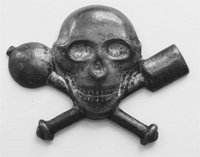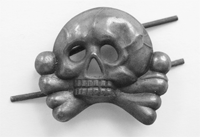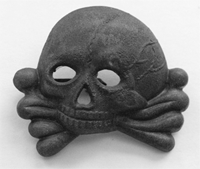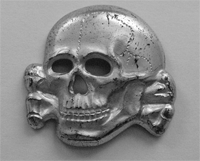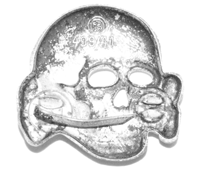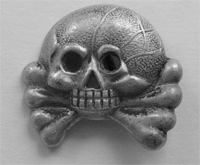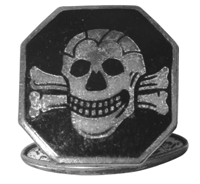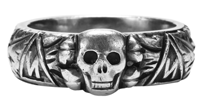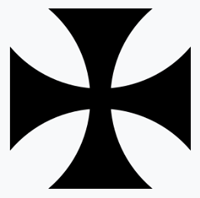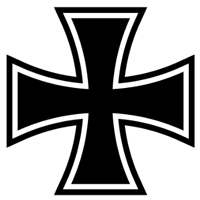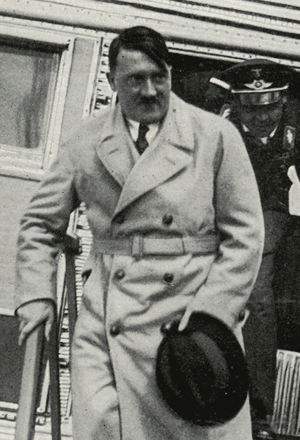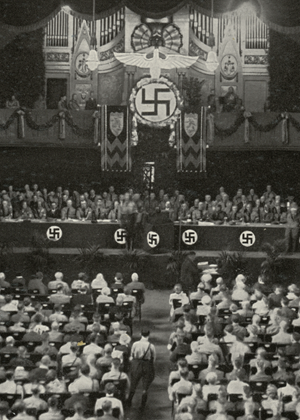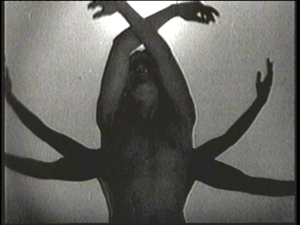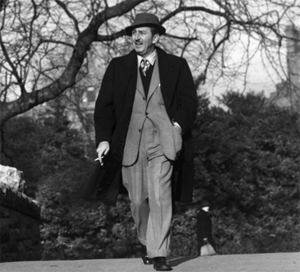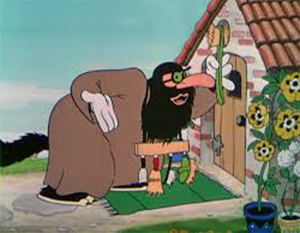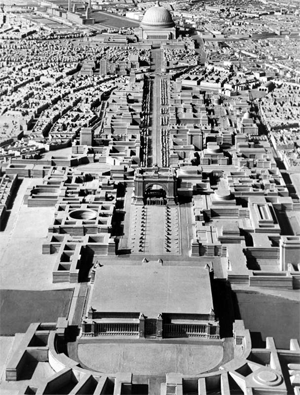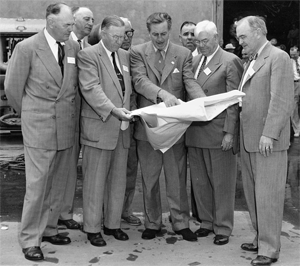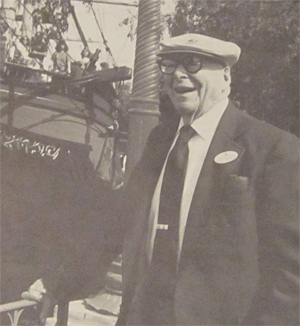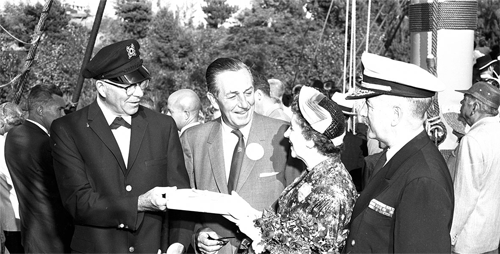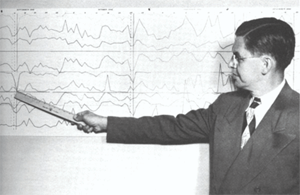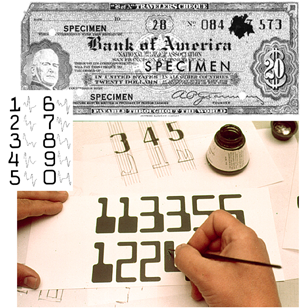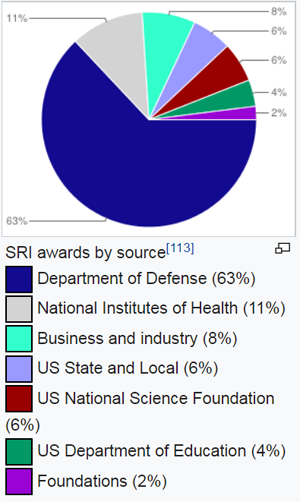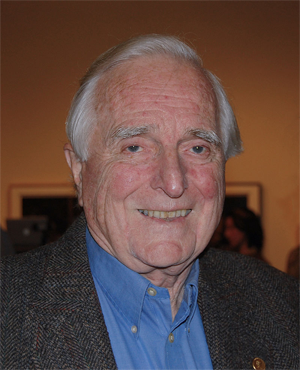by EvanTubeHD
October 20, 2012
NOTICE: THIS WORK MAY BE PROTECTED BY COPYRIGHT
YOU ARE REQUIRED TO READ THE COPYRIGHT NOTICE AT THIS LINK BEFORE YOU READ THE FOLLOWING WORK, THAT IS AVAILABLE SOLELY FOR PRIVATE STUDY, SCHOLARSHIP OR RESEARCH PURSUANT TO 17 U.S.C. SECTION 107 AND 108. IN THE EVENT THAT THE LIBRARY DETERMINES THAT UNLAWFUL COPYING OF THIS WORK HAS OCCURRED, THE LIBRARY HAS THE RIGHT TO BLOCK THE I.P. ADDRESS AT WHICH THE UNLAWFUL COPYING APPEARED TO HAVE OCCURRED. THANK YOU FOR RESPECTING THE RIGHTS OF COPYRIGHT OWNERS.
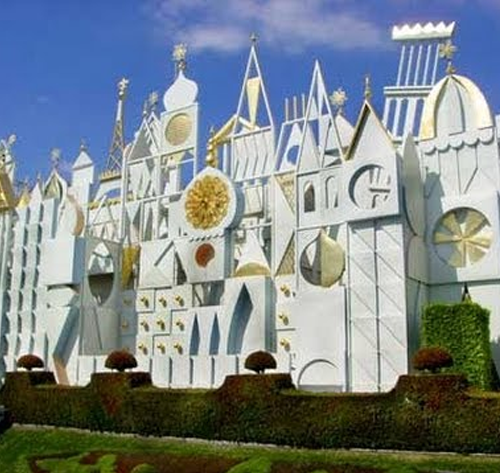

The Totenkopf (death’s head) was one of the most readily recognized symbols of the Nazi Schutzstaffel (SS), Adolf Hitler’s elite black guard and ideal Teutonic knighthood, along with other select Germanic political and armed forces of the Third Reich period. The distinctive insignia were worn as cap or collar devices on many unique paramilitary and military uniforms. But despite the strong association with Hitler’s State, death’s head insignia were in use many years prior to the Nazi Party coming into being.
Storm trooper units wore a death’s head design, such as one over crossed grenade and mace.
One of the first recorded accounts of the skull and cross bones in German military history was in the early half of the 17th century during the Thirty Years War when Bavarian troopers, known as the “Invincibles” wore black uniforms with white Totenkopfs on their helmets. During the reign of Fredrick the Great in the late 18th century, a Prussian Hussar (light cavalry) regiment was formed that wore similarly imposing black uniforms with Totenkopfs affixed to the front of their high caps. These insignias were meant to strike fear into their opponents, by demonstrating that the wearer’s duty outweighed his regard for personal safety (an affront to death), while at the same time signifying his loyalty to the monarchy at all costs “unto death.”
Traditional death’s head badges were worn by various units in The Great War.
When, Friedrich Wilhelm, the Duke of Brunswick-Wolfenbuttel, was killed in 1815 during the Napoleonic wars, his grave was guarded for many years afterward by members of his Brunswick Cavalry Regiment who wore the death’s head as a sign of mourning for the fallen leader. Select German cavalry units continued to wear the death’s head insignia throughout the remainder of the 19th and early 20th centuries.
The first type SS cap badge followed the design of the older traditional badges.
During WWI, Totenkopf insignia was used by a number of German units such as the Black Hussars, Black Brunswickers, and the 21st Battalion of the Chasseurs. In addition, men of the Sturmtruppen (assault troops or “storm troopers”) units of the German army wore various Totenkopf insignia to show their voracity in battle. These elite combat forces were highly trained in infiltration and the hand-to-hand combat needed to break the long and costly stalemates that characterized trench warfare. Meanwhile, in the air above the trenches, some German aviators painted death’s head insignias on the fuselages of their aircraft, demonstrating their prowess in battle as agents of death to the enemy above and below.
The final SS death’s head design was a realistic skull produced for headgear in plated metal or aluminum.
Following the Great War, the German nationalist veterans’ paramilitary group, Der Stahlhelm (Steel helmet), painted Totenkopf insignia on their helmets, equipment, and vehicles. The Totenkopf could be seen when these units organized, paraded, and fought in the streets during the chaotic unrest of the Weimer government.
RZM and manufacturer’s markings were often cast onto the reverse of SS Totenkopf cap badges.
In the early days of the Nationalsozialistische Deutsche Arbeiterpartei (NSDAP – Nazi Party), Adolf Hitler ordered that a small group of unquestioningly loyal party members become his personal guard unit for the many rallies and gatherings at which he spoke. In 1923, this group adopted the Totenkopf on their headgear as a sign of the emblem’s past royal parentage, and to show their loyalty to the leader. Through time, the small guard eventually evolved into the SS which wore the death’s head emblems as part of both their Allgemeine (general – black) and Waffen (armed – gray-green) uniforms and headgear.
Some panzer units wore traditional style death’s heads on their collar tabs.
The construction of the SS death’s head transformed over time. The earliest took the form of a rounded, traditional jawless skull over short crossed bones. This was worn from 1923 until 1934. The second, a more realistic human skull complete with a jaw and short femur tips protruding from the back, as in use from 1935 to 1945.
When produced in metal for cap or collar tab usage, the first type was often constructed of zinc or other alloys, while the second type came in plated metal or polished alloys. Each had prongs soldered or crimped to the reverse for mounting, while the later models often contained manufacturer codes and “Reichszeugmeisterei” (RZM – government control agency ) markings.
Officers could purchase privately manufactured death’s head items such as this SS cuff link.
In addition to the SS, certain German Army and Luftwaffe armored divisions also wore the Totenkopf emblems on their uniform collar tabs, as well as other varieties worn on caps by Brunswick units as a traditions badge.
An official jewelry item was the SS ring which featured a Totenkopf and runic symbols around the exterior.
All of these devices were dutifully worn by their bearers until the bloody hostilities of the European front came to an end. The new, free Germany eliminated the Totenkopf from is uniforms after Adolf Hitler and his brutal dictatorship were terminated by the allies.
-- Totenkpf: Nazi German's "Death Head," by Chris William
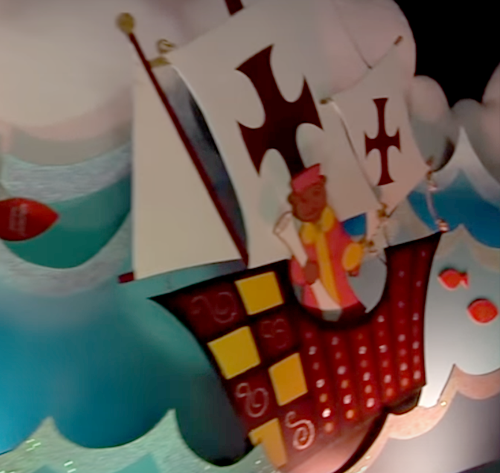
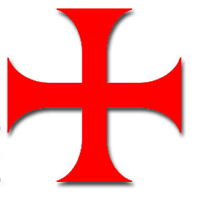
The red cross on a white background, was associated with the Knights Templar, and by 1188, the English and French troops of Phillip II of France and Henry II of England, proudly displayed it, as part of their tunic. It became a symbol, worn by many troops, announcing they be warriors fighting crusades in the Holy Land. -- Knights Templar: St. George's Cross, by Crusader History
Who was Lanz von Liebenfels, and how did he manage such an emotional impact on young Hitler?...His Order of the New Templars was an occult lodge that met at a ruined castle high on a cliff over the Danube -- the eerie Burg Werfenstein in Upper Austria, a few miles upriver from Hitler's childhood home -- among other sites. The members wore white, surplice-style robes emblazoned with the red cross of the Templars, a cross that von Liebenfels believed was formed of two, superimposed and counter-rotating, swastikas....According to von Liebenfels, however, the solution to the problem of the incipient physical and spiritual degeneration of the Aryan race was not hatha yoga or Transcendental Meditation but the creation of a new priesthood of the Holy Grail; a new Knights Templar of the German Blood (for that was, according to von Liebenfels, what the Grail represented). As for the inferior races? They were to be deported; or incinerated as a sacrifice to God; or simply used as slave labor. All of these proposals -- from Knights Templar to slave labor, from Holy Grail to crematoria -- were to be accepted, incorporated, and expanded upon by Adolf Hitler personally, and by the Third Reich as official policy. It was also von Liebenfels who proposed that the finest specimens of Aryan males should mate indiscriminately with the finest specimens of Aryan females in specially controlled and tightly monitored villages in order to create the super race. This would, of course, be a cause taken up by Himmler's Lebensborn organization to which every SS officer was expected to belong. Lanz von Liebenfels and his mentor Guido von List can be viewed as archetypal Social Darwinists and the Third Reich as Social Darwinism carried to its logical conclusion. Similar to the rationale behind the race eugenics programs in the United States (which also influenced American immigration policies, both of which the Nazis regarded with admiration and approval), it was an ideology of the survival of the fittest, and the enslavement and destruction of the weakest, from Jews to women, from the mentally and physically handicapped to the aged, from Slavs and Gypsies to Communists.
-- Unholy Alliance: A History of Nazi Involvement With the Occult, by Peter Levenda
Form of Cross Pattée used on German military aircraft in 1915. -- Luftstreitkräfte, by Wikipedia
The Iron Cross is a former military decoration in the Kingdom of Prussia, and later in the German Empire (1871–1918) and Nazi Germany (1933–1945). It was established by King Friedrich Wilhelm III of Prussia on 17 March 1813 during the Napoleonic Wars (EK 1813). -- Iron Cross, by Wikipedia

Kortzfleisch reveals to Obi that he is a Vril, a race of Reptilians that arrived on Earth during the age of the dinosaurs. While studying the primates that emerged during prehistory, Kortzfleisch created humankind by injecting vrilia into an apple and feeding it to his monkeys Adam and Eve. The Vril have since gone underground to the center of the Earth once mankind had evolved. Kortzfleisch offers Obi a mission to travel to the subterranean city of Agartha and take the city's Vrilia to ensure the survival of her colony. -- Iron Sky, by Wikipedia
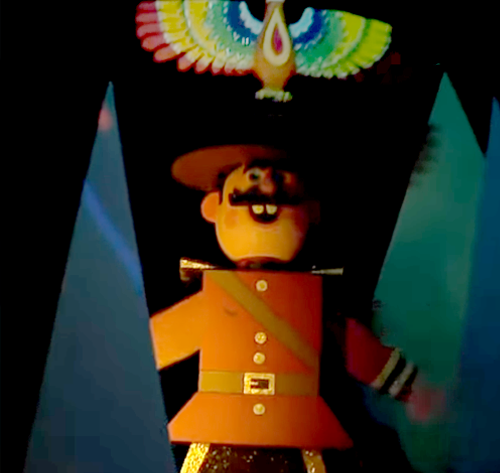
The Reichsadler ("Imperial Eagle") is the heraldic eagle, derived from the Roman eagle standard, used by the Holy Roman Emperors and in modern coats of arms of Germany, including those of the Second German Empire (1871–1918), the Weimar Republic (1919–1933) and the Third Reich (Nazi Germany, 1933–1945). -- Reichsadler, by Wikipedia
W. E. Coleman has shown that her work comprises a sustained and frequent plagiarism of about one hundred contemporary texts, chiefly relating to ancient and exotic religions, demonology, Freemasonry and the case for spiritualism. Behind these diverse traditions, Madame Blavatsky discerned the unique source of their inspiration: the occult lore of ancient Egypt. Her fascination with Egypt as the fount of all wisdom arose from her enthusiastic reading of the English author Sir Edward Bulwer-Lytton. His novel The Last Days of Pompeii (1834) had been conceived of as a narrative of the impact of the Isis cult in Rome during the first century AD. His later works, Zanoni (1842), A Strange Story (1862), and The Coming Race (1871), also dwelt on esoteric initiation and secret fraternities dedicated to occult knowledge in a way which exercised an extraordinary fascination on the romantic mind of the nineteenth century. -- The Occult Roots of Nazism: Secret Aryan Cults and Their Influence on Nazi Ideology: The Arisophists of Austria and Germany, 1890-1935, by Nicholas Goodrick-Clarke
-- James S. Corum, "The Old Eagle as Phoenix: The Luftstreitkrufte Creates an Operational Air War Doctrine, 1919-1920

[T]here was a tradition of anti-Jewish sentiment in the Islamic world that went back to the seventh century and accounts of the Prophet's dealings with the Qurayzah Jews in Medina. Even some tales added to 17th- and 18th-century manuscripts of The Arabian Nights contain foul anti-Semitic slanders. This sort of anti-Semitism persists in some Muslim circles....The Nazis, encouraged by Arab readiness to believe the worst of the Jews, considered presenting Hitler as the Mahdi before regretfully concluding that this was impossible as he did not belong to the Prophet's tribe, the Quraysh. Himmler was disappointed to find that the Qur'an did not predict Hitler's ultimate victory. -- Nazi Propaganda for the Arab World, by Jeffrey Herf, Reviewed by Robert Irwin, The Independent
To return to the Nights, the stories that form part of the early core of the story collection are fairly free of anti-Semitism and there are no disparaging comments about Jewish physiognomy. For example, the Jewish doctor in the ‘Hunchback’ cycle of stories is presented as the equal of the Muslim storytellers he is with. Moreover the Nights contains several stories about pious Israelites. But some of the stories that were later added to the corpus of Nights have a nasty feel. For example, in ‘Three princes of China’, two of the princes are murdered by a Jewish community in Iraq and rolled inside mats, but when the third prince arrives, he tricks the leader of the Jews into killing his own son. In ‘Masrur and Zayn al-Mawasif’ Zayn al-Mawasif’s Jewish husband is cuckolded by Masrur and ends up being buried alive by a slave-girl. In ‘The fisherman and his son’ the fisherman gets the jinni at his command to throw a Jewish merchant into the fire. Villainous and drunken Jewish pirates feature in ‘The merchant’s daughter and the prince of al-Iraq’. -- The Dark Side of ‘The Arabian Nights’, by Robert Irwin

Famed Disney animator Art Babbitt, who worked closely with Disney, once claimed—as quoted in Peter Fotis Kapnistos’ book Hitler’s Doubles—that “in the immediate years before we entered the War [World War II] there was a small, but fiercely loyal, I suppose legal, following of the Nazi party…There were open meetings, anybody could attend and I wanted to see what was going on myself. On more than one I occasion I observed Walt Disney and Gunther Lessing [Disney’s lawyer] there, along with a lot of prominent Nazi-afflicted Hollywood personalities. Disney was going to these meetings all the time.” They were none other than the meetings of the German American Bund, or the American Nazi Party. Disney also personally hosted Nazi filmmaker Leni Riefenstahl when she came to promote her film Olympia in 1938, a month after the infamous assault on Jews known as Kristallnacht. Disney gave the propagandist a grand tour of his studio, and Riefenstahl even commented that it was “gratifying to learn how thoroughly proper Americans distance themselves from the smear campaigns of the Jews.” This is documented in the Steve Bach biography about the filmmaker titled Leni. -- Walt the Quasi-Nazi: The Fascist History of Disney is Still Influencing American Life, by Ryan Beitler
In 1938, on a US tour to promote the movie, Riefenstahl gushed to a reporter: “To me, Hitler is the greatest man who ever lived. He truly is without fault, so simple and at the same time possessed of masculine strength.” The timing was disastrous – a few days after her arrival in New York came Kristallnacht, when the Nazis destroyed 1,000 synagogues and imprisoned 30,000 Jews. The Hollywood invitations evaporated and she met only Walt Disney. -- A cinematic genius and Hitler favourite: the dark story of Leni Riefenstahl, by The Telegraph
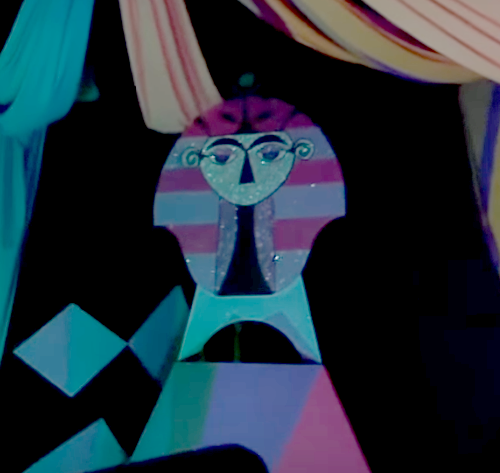
In 1886 Hubbe-Schleiden stimulated a more serious awareness of occultism in Germany through the publication or a scholarly monthly periodical, Die Sphinx, which was concerned with a discussion of spiritualism, psychical research, and paranormal phenomena from a scientific point of view. Its principal contributors were eminent psychologists, philosophers and historians. Here Max Dessoir expounded hypnotism, while Eduard von Hartmann developed a philosophy of 'individualism', according to which the ego survived death as a discarnate entity, against a background of Kantian thought, Christian theology, and spiritualist speculations. Carl du Prel, the psychical researcher, and his colleague Lazar von Hellenbach, who had held seances with the famous American medium Henry Slade in Vienna, both contributed essays in a similar vein. Another important member of the Sphinx circle was Karl Kiesewetter, whose studies in the history of the post- Renaissance esoteric tradition brought knowledge of the scholar magicians, the early modern alchemists and contemporary occultism to a wider audience. While not itself theosophical, Hubbe-Schleiden's periodical was a powerful element in the German occult revival until it ceased publication in 1895....In December 1907 the Sphinx Reading Club...was founded by Franz Herndl, who wrote two occult novels and was an important member of the List Society. -- The Occult Roots of Nazism: Secret Aryan Cults and Their Influence on Nazi Ideology: The Arisophists of Austria and Germany, 1890-1935, by Nicholas Goodrick-Clarke
In the fall of 1911 Dietrich Eckart finished his "translation" of Henrik Ibsen's Peer Gynt....Peer then journeys to Egypt with the idea of becoming Emperor of the World. Things go awry. He bumps into a gold-digging dancer named Anitra, who makes off with most of his money. Peer eventually winds up in a Cairo madhouse talking to a Sphinx. He prays to God, "Guardian of all madmen," but sinks into despair because "He's not listening. He's deaf as usual. That's charming! A God who won't help when you need Him." -- Hitler's Mentor: Dietrich Eckart, His Life, Times, & Milieu, by Joseph Howard Tyson

According to Heinar Schilling, the Germanic peoples of the Late Bronze Age had adopted a four-spoke wheel as symbolic of the sun "and this symbol has been developed into the modern swastika of our own society [i.e., Nazi Germany] which represents the sun." Under the sign of the swastika "the light bringers of the Nordic race overran the lands of the dark inferior races, and it was no coincidence that the most powerful expression of the Nordic world was found in the sign of the swastika". Very little had been preserved of the ancient rites, Professor Schilling continued, but it was a striking fact "that in many German Gaue today on Sonnenwendtage (solstice days) burning sun wheels are rolled from mountain tops down into the valleys below, and almost everywhere the Sonnenwendfeuer (solstice fires) burn on those days." He concluded by saying that "The Sun is the All-Highest to the Children of the Earth". -- Religious Aspects of Nazism, by Wikipedia
Perhaps the most central neopagan element in German volkisch movements was sun worship. [16] The worship of the sun was extolled as true ancient Teutonic religion, and while it was primarily a literary device and a powerful rhetorical metaphor for the experience of God, actual solar-worship rituals did take place among some volkisch groups during the annual summer solstice, especially between the very early 1900s and the 1930s. As a direct consequence of this Germanic neopaganism, in the 1930s the Nazi government banned the celebration of traditional Christian holidays and instead substituted others more appropriate for the "New Germany." The summer solstice was designated as one of these holidays. -- The Jung Cult: Origins of a Charismatic Movement, by Richard Noll


